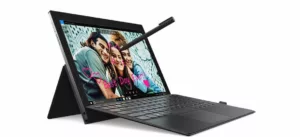Back when Steve Jobs was alive he launched the iPad and scared the crap out of the PC industry whose collective lives evidently passed before their eyes. The concept of a 2-in-1 was conceived as a flawed counter strategy to the iPad’s apparent, at the time, dominance. Many falsely believed it was the last, best hope for laptop computers. But since then the iPad dropped into decline and the Amazon Kindle, which just passed Samsung for the number two spot in tablets, rose up growing up to 50% in sales during its high-volume holiday season sales. But the Kindle poses no threat to laptops and the only “tablets” that are also fighting what continues to be a 12% decline in tablet sales are the Microsoft Surface and iPad Pro. These are both tablet centric 2-in-1 offerings.
The Lenovo Miix 630 which just came out arguably represents the state of the art in true 2-in-One products. It gets there by using the Qualcomm Snapdragon 835 solution rather than x86 which gives it up to 20 hours battery life. In tablet form, thanks to the battery life, it is a true tablet not a laptop with an identity crisis and performs adequately as a laptop.
Since I’m a big Kindle user myself I thought I’d compare the two products to see in anything interesting results. Because my ideal 2-in-1 would be a Kindle/PC mix so I didn’t have to buy and carry both.
Amazon Fire HD 10
Fire HD 10 users are the minority of Amazon Kindle buyers but also the most loyal and the most likely to buy the latest version according to one of the folks I talked to at Amazon. This is the product closest to the original iPad and, in its most expensive form (it starts at $149) it sells for $204.99. It is a subsidized product which means Amazon sells it for near cost and, during sales, will allow it to drop below cost.
Amazon can do this because the Kindle is basically a portal into Amazon and a nearly dedicated one at that. Kindle users are also Amazon shoppers and the value of having a dedicated digital portal into a store is invaluable. I’ve often wondered why folks like eBay and Walmart haven’t countered with their own dedicated hardware portals but, I expect, it is because they just don’t have the skill set.
The device is a consumption device, yes you can do email, but it is best as a device you shop from, use to read, or watch video, or play a small set of games (game inventory is light). It has an OK browser and can be used to browse the web, but it lags other platforms in this regard. It also runs Alexa which now allows the device, with the new dock, to morph into an Echo like product. Kind of a different 2-in-1 if you think about it.
So, the Kindle Fire HD 10 is a store front consumption device often selling below cost because Amazon gets so much value out of it.
Lenovo Miix 630
The Lenovo Miix 630 is really what a 2-in-1 should have always been but we just didn’t have the technology. It runs full Windows 10 (it ships with Windows S, but you can upgrade it to 10 for free) which means full versions of Office and most Windows 32 apps (it will run Windows 64 apps but often very poorly). It has 4G WAN connectivity built in and this is designed to be a connected device. (Interesting note, the first Kindle readers were connected with free WAN services). The tablet form of this product is also tablet light weighing in under 2 lbs.
As with most all Windows products this is a creation device but trades off performance for battery life so apps for video and photo editing will likely perform poorly on it and a game machine this isn’t. So, in laptop form, for those of us that largely live off Office and browsers, it is brilliant, but it will lag significantly an x86 laptop for performance oriented or 64-bit apps. The rumored coming Qualcomm Snapdragon 1000 processor should improve the performance of the next generation of this thing significantly.
As a tablet it is, at near 13”, big. The bigger problem is that getting content on it is far more difficult than it is on a Kindle. Amazon has been reticent to allow movie downloading on Windows, the Kindle reader for Windows is harder to use than the one on the Kindle, and you are left with a far more disjointed app-based experience overall. For those of us that live on Windows this sounds worse than it is because we are used to it, but you learn to really appreciate the Kinde’s very different way of orienting and presenting functions that are core to the device.
I think, if the user interface was tweaked, so that it morphed into a consumption-oriented interface when the device was in tablet form it would be a far more compelling tablet particularly if Amazon updated their apps and allowed more movie downloads on it. As it is this 2-in-1 would likely be best for those that like to draw (it has an active stylus and a place to keep it, so you don’t lose the damn thing), live in a form-oriented world, or edit using a pen.
Wrapping Up:
Right now, the tablet market is more at threat from dedicated products like the Amazon Kindle or ever larger smartphones than it is from PCs, and the PC market is suffering more from a lack of demand generation than the fading tablet threat. The perfect 2-in-1 or future tablet might actually be a Smartphone and with foldable screens (Microsoft Andromeda) or head mounted displays (Hololens) both of which are coming, I expect, that by 2030 we’ll be wondering why we tolerated these far more limited devices. Ironically Microsoft had what was likely the ideal platform for a true 3-in-1 which was called Continuum, but they were too early to market.
Now, prior to this evolution, a product like the Miix 630 that would flip to the Kindle interface when in tablet form and gain access to Amazon subsidies to reduce price would be very interesting and might reset the bar again for this 2-in-1 class. Something to think about this weekend.








